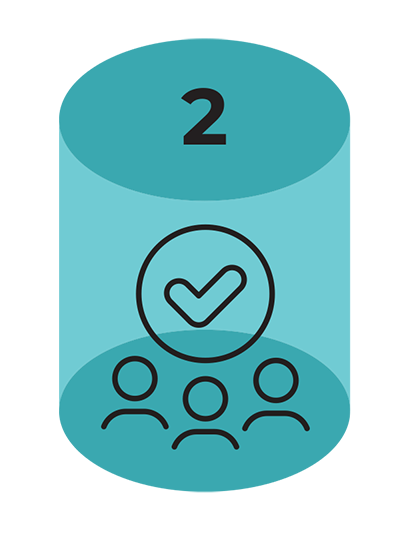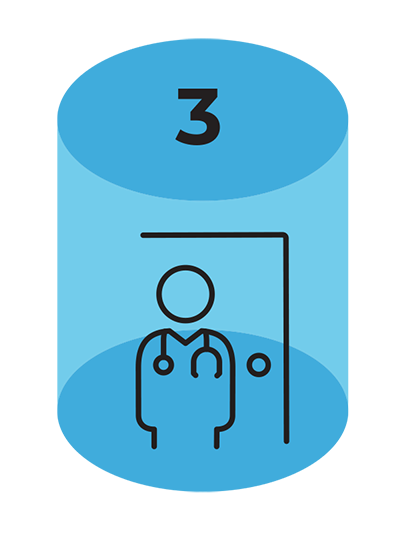Research for a healthier Canada
One of the most important investments we can make as a nation
At the Canadian Institutes of Health Research (CIHR), we believe research has the power to change lives.
As the Government of Canada's health research investment agency, we fund world- class research across the country to strengthen our health care system, find solutions to the most pressing health challenges, and improve the health of Canadians and people around the world.
Comprised of 13 research institutes and headquarters in Ottawa, we are an independent agency that reports to Parliament through the Minister of Health. CIHR was created in 2000 when the Canadian Institutes of Health Research Act was signed into law.
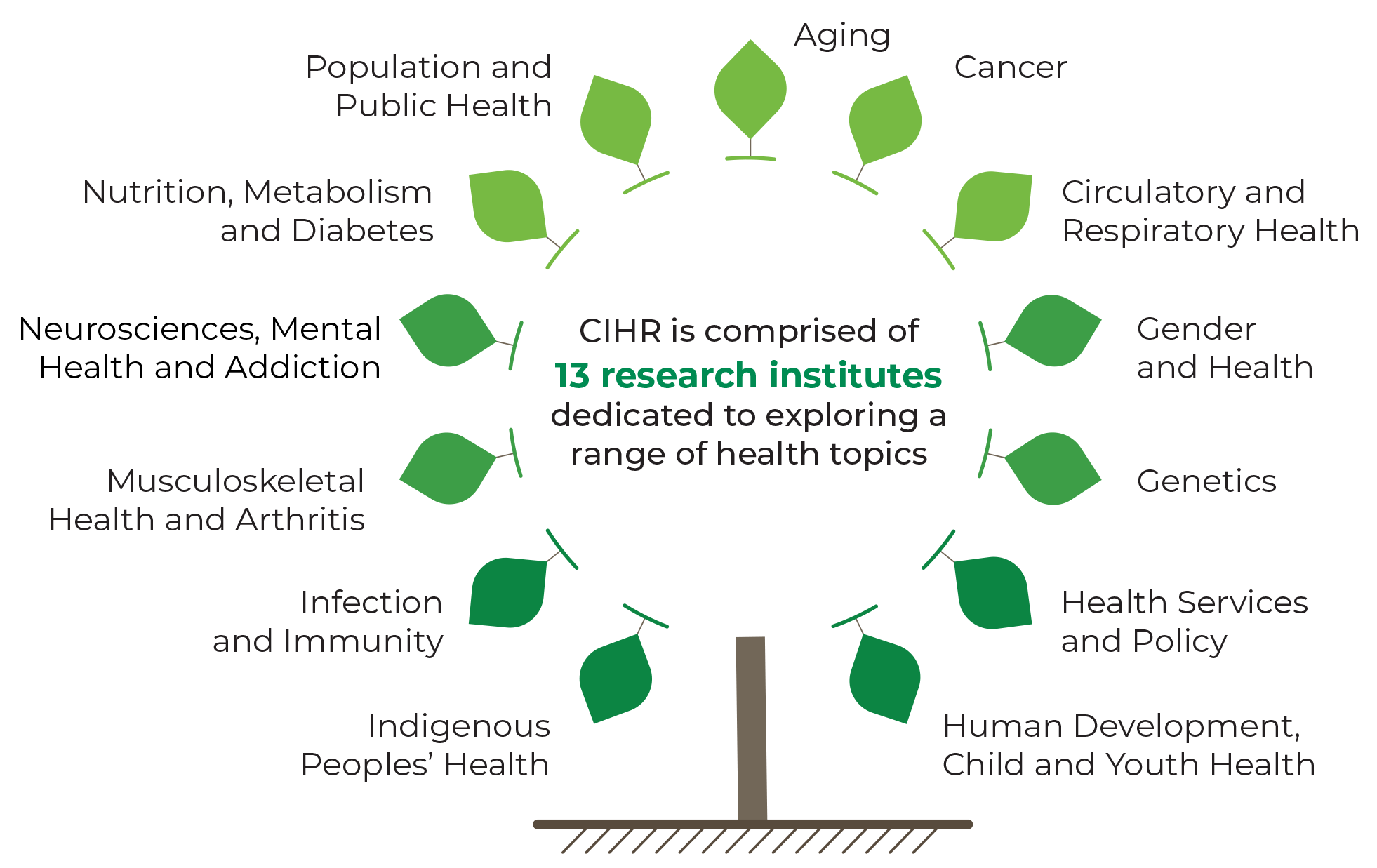
Long description
CIHR is comprised of 13 research institutes dedicated to exploring a range of health topics:
- Aging
- Cancer
- Circulatory and Respiratory Health
- Gender and Health
- Genetics
- Health Services and Policy Research
- Human Development, Child and Youth Health
- Indigenous Peoples' Health
- Infection and Immunity
- Musculoskeletal Health and Arthritis
- Neurosciences, Mental Health and Addiction
- Nutrition, Metabolism and Diabetes
- Population and Public Health
Overall strategic directions are set by our Governing Council, which has a mandate to oversee the direction and management of the property, business and affairs of CIHR.
The executive management team provides leadership and strategic decision-making for Agency-wide management areas, including Corporate Services, Research Programs, Operations, Strategy, and Government and External Relations.
A Vision for a Healthier Future
CIHR's 2021-2031 Strategic Plan envisions a future where Canadian researchers are global leaders in the development of ground-breaking discoveries that improve lives in Canada and around the world. CIHR will achieve this vision by prioritizing activities that:

advance research excellence in all its diversity by championing a more inclusive concept of research excellence, supporting stronger research teams, promoting open science, and enhancing national and international collaboration;

strengthen Canadian health research capacity by strengthening investigator-initiated research, promoting equity, diversity, and inclusion among researchers, and enhancing training and career support as well as CIHR's rapid response capacity;

accelerate the self-determination of First Nations, Inuit, and Métis Peoples in health research by implementing the strategic plan of the Institute of Indigenous Peoples' Health and CIHR's Building a Healthier Future action plan, and by removing barriers to Indigenous-led research;

pursue health equity through research by championing research on inequitable health outcomes, access to health care in Canada, and the determinants of health, and by driving progress on global health research; and

integrate evidence in health decisions by advancing the science of knowledge mobilization, maximizing results for Canadians, and strengthening Canada's health systems through innovation.
CIHR Investments: By the Numbers
CIHR has a big role to play in keeping Canadians healthy. In 2022-23, we invested:

Long description
$1B+ of taxpayer money plus $125M+ of partner funding to support 16,000 independent health researchers and trainees through 100+ funding competitions.
Of this $1 billion, CIHR invests more than 90% of its budget directly in health research activities.
Each year, CIHR's grants and awards expenditures are divided into two main categories to reflect CIHR's financial management investment flexibility in its programs:
Category 1: Discretionary funding
The discretionary funding category represents the portion of funding over which CIHR has financial management and investment flexibility. These funds support a variety of programs, including investigator-initiated research programs, training and career support programs, and research in priority areas.
In 2022-23, the discretionary funding category represented about 64% of the total grants and awards expenditures, or approximately $804.7 million.
Category 2: Non-discretionary funding
The non-discretionary funding category is divided into Government of Canada Priorities (also known as Ring-Fenced Funds) and Tri-Agency Programs (also known as Separately Listed Grants). Investments in this category are prescribed by the Government of Canada and can only be used for the prescribed purposes.
For 2022-23, the non-discretionary funding category represented about 36% of the total grants and awards expenditures, or approximately $453.7 million.
Budget Overview (2022-23)
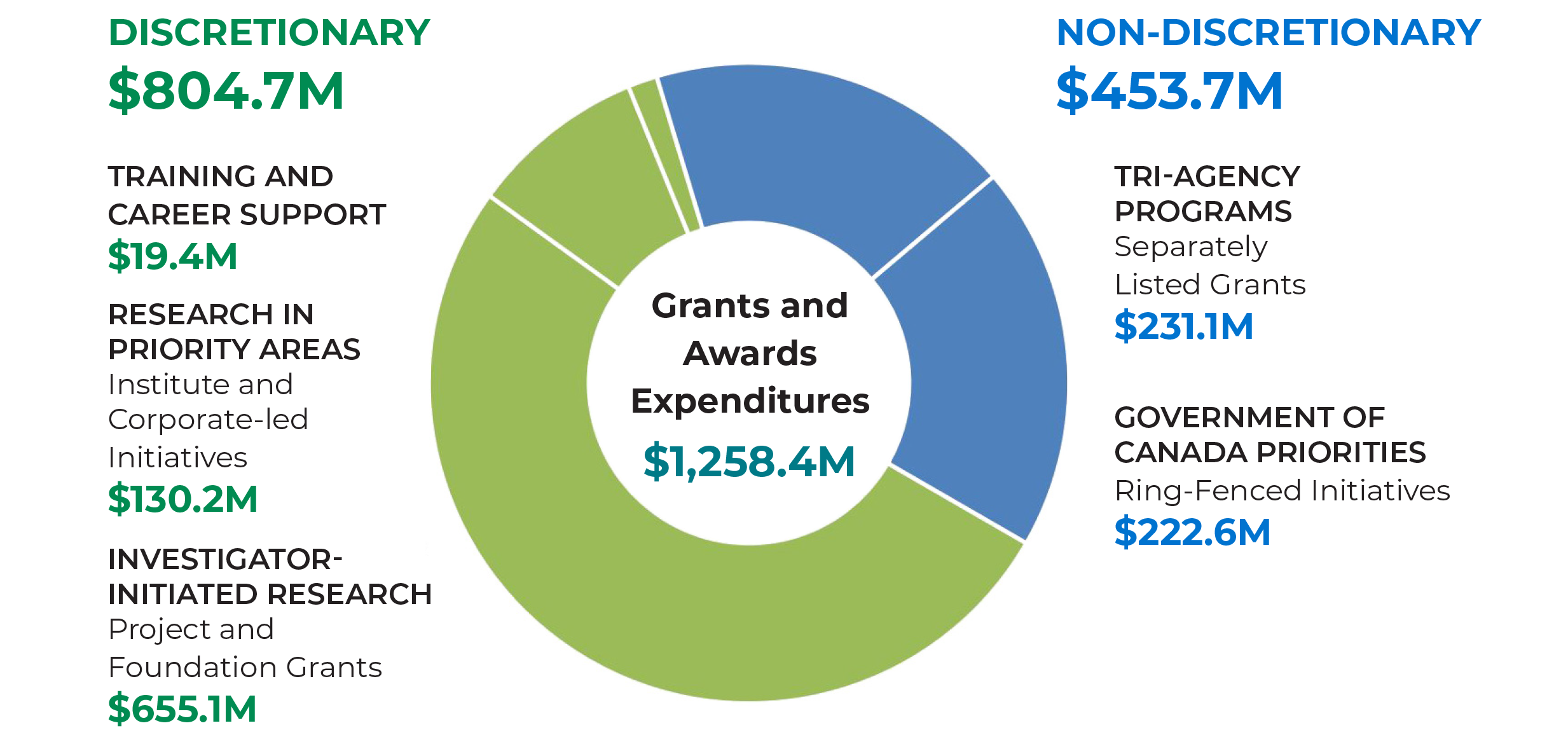
Long description
Discretionary - $804.7M
- Training And Career Support - $19.4M
- Research In Priority Areas (Institute and Corporate-led Initiatives) - $130.2M
- Investigator- Initiated Research (Project and Foundation Grants) - $655.1M
Non-discretionary - $453.7M
- Tri-agency Programs (Separately Listed Grants) - $231.1M
- Government of Canada Priorities (Ring-Fenced Initiatives) - $222.6M
Grants and Awards Expenditures - $1,258.4M
Partnerships for Impact
It takes a village to support innovative and life-changing health research. This is why CIHR is proud to work with national and international partners across all sectors to fund top research projects. By playing a leadership role in convening a united community of partners, CIHR helps to create a vibrant health research ecosystem and achieve maximum impact for Canadians.
Leveraged Partner Funding by Sector in 2022-23
(in millions of dollars)
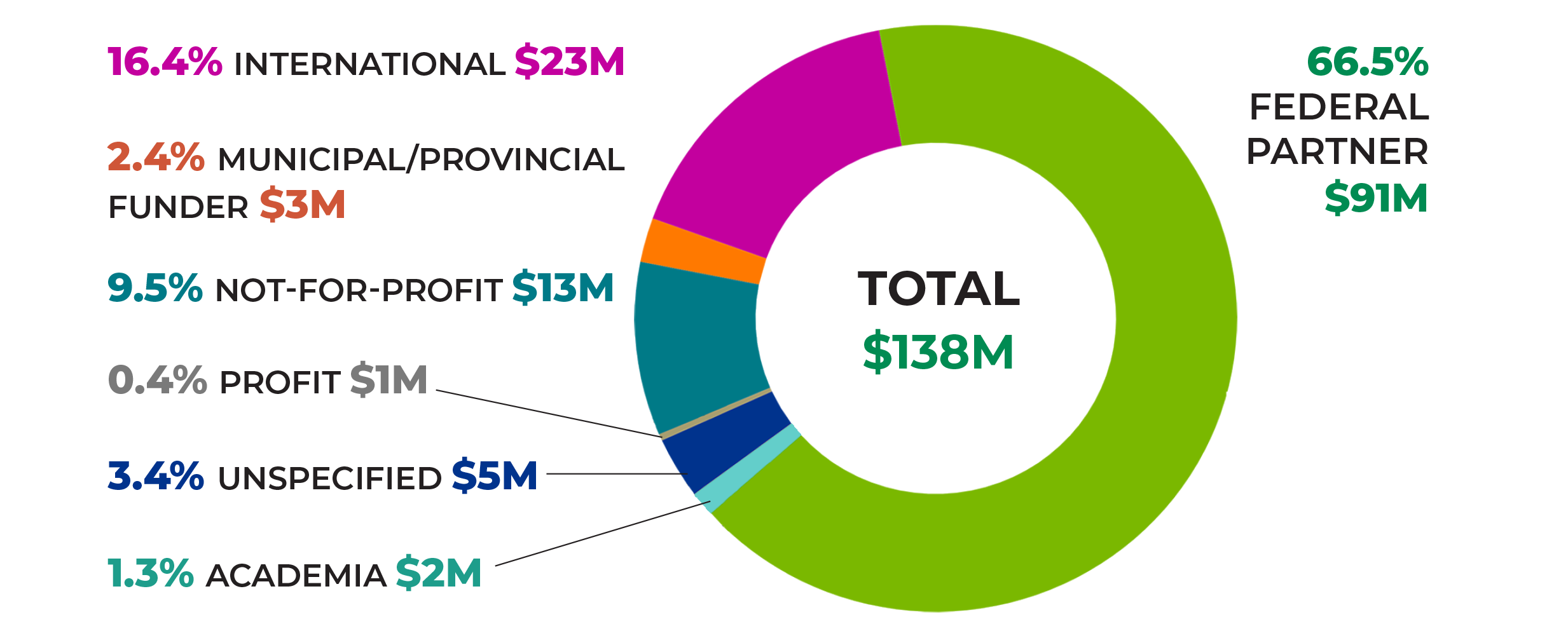
Long description
- Federal partner - $91M (66.5%)
- International - $23M (16.4%)
- Municipal/provincial funder - $3M (2.4%)
- Not-for-profit - $13M (9.5%)
- Profit - $1M (0.4%)
- Unspecified - $5M (3.4%)
- Academia - $2M (1.3%)
Total - $138M
Supporting All Pillars of Health Research
CIHR's investments cover a vast range of health challenges spanning across four main pillars:
Together, these pillars aim to improve the overall health of communities across Canada and around the world.
1. Biomedical research
Biomedical research focuses on understanding how every part of the human body works—right down to our cells. By studying the normal and abnormal workings of the body at the molecular, cellular, organ system, and whole-body levels, biomedical research leads to new:

Ways of identifying and diagnosing disease

Interventions to prevent illness in the first place

Tools and equipment to enhance patient care and health outcomes

Medicines, vaccines, and therapies to improve our health
Spotlight on

Dr. Juliet Daniel | McMaster University
There isn't currently a cure for breast cancer – but that isn't stopping Dr. Juliet Daniel from finding new treatments and therapies for women living with Triple Negative Breast Cancer, an aggressive form that predominantly affects young Black women. Read more
Dr. Edan Foley | University of Alberta
Did you know that studying the guts of fruit flies can help us learn more about human immunity and disease? Through these flies, Dr. Edan Foley is uncovering how inflammatory bowel disease and colorectal cancers develop in humans. Read more

2. Clinical research
Clinical research aims to find new ways of preventing, diagnosing, and treating disease and illness. With the help of volunteer participants, clinical research leads to new and improved:

Medications, vaccines, therapies and treatments

Medical tests, procedures and practices

Medical tools, equipment and devices

Scientific knowledge and understanding of illness and disease
There are two main types of Clinical Research:

Observational studies
In observational studies, researchers use questionnaires and medical tests to collect and analyze data about patients' health, habits and behaviours, biology, bodily functions and changes, and more. This helps researchers better understand the factors that contribute to health or disease.

Clinical trials
In clinical trials, researchers test a new intervention – like a vaccine, medical device, or health program – and compare the results with a placebo group (i.e., a group that did not receive the intervention). This helps researchers determine whether the new intervention is safe and (more) effective for patients.
Spotlight on
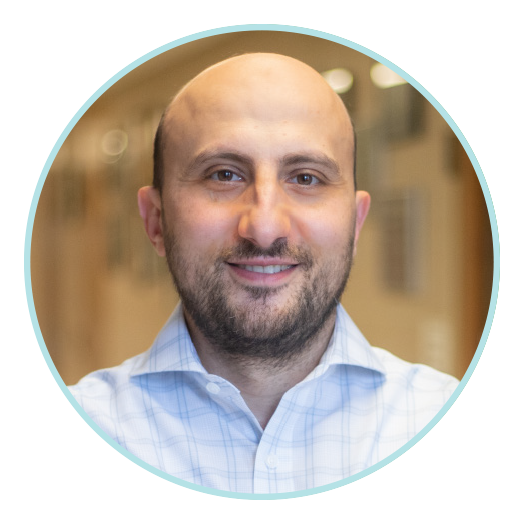
Dr. Mohammad Auais | Queen's University
A hip fracture can be life-changing for older adults, but it doesn't have to be this way. With his "Stronger at Home" program, Dr. Mohammad Auais is helping hip fracture patients recover and rehabilitate in their own homes—and regain their independence in the process. Read more
Dr. Erin Michalak | University of British Columbia
Bipolar disorder is a serious health condition that affects over half a million people in Canada – but with proper care and support, people living with this condition can flourish. Dr. Erin Michalak is developing practical, accessible and personalized online tools and resources to help people with bipolar disorder thrive. Read more


Dr. Elaine Biddiss | Holland Bloorview Kids Rehabilitation Hospital
For children living with physical disabilities like cerebral palsy, it can be challenging (and boring!) to stick to a regular physical and rehabilitation therapy program. To keep them on track, Dr. Elaine Biddiss created "Bootle Blast," an interactive video game for children that helps them improve their motor skills in a fun and engaging way. Read more
3. Health services research
Health services research helps improve the efficiency and effectiveness of Canada's health care system so all Canadians can get the help they need, when they need it. By studying how health care services are organized, supported, and delivered across the country, this multidisciplinary field of research has four primary goals:

Enhance the quality of care for patients

Improve the health care provider experience

Reduce costs by maximizing the value of care

Improve the overall health of the population
Spotlight on

Dr. Emily Gard Marshall | Dalhousie University
We know that more than 5 million Canadians do not have a family doctor. It's a complicated issue, but Dr. Emily Gard Marshall argues that research is part of the solution. Her own research on primary care can help us understand what is working, what is not, and why. Read more
Dr. Tom Stelfox | University of Calgary
In theory, the transition and support system for patients being discharged from the intensive care unit (ICU) sounds straightforward. In practice, however, it's not so easy. That's why Dr. Tom Stelfox is developing practical, evidence-based tools to help patients, their families, and care providers navigate the path to long-term recovery after a stay in the ICU. Read more

4. Social, cultural, environmental and population health research
Social, cultural, environmental, and population health research aims to improve the health of entire communities by understanding how our health is impacted by:

Social Factors
Such as your age, sex and gender, education, and social support network

Cultural Factors
Such as practices, beliefs, expectations and norms

Economic Factors
Such as household income, stability, and cost of living

Environmental Factors
Such as the city and country you live in, housing, and living conditions

Occupational Factors
Such as employment status, security, and work conditions
Spotlight on

Dr. Daniel Fuller | University of Saskatchewan
Urban planning and infrastructure design can affect our health in big ways. Dr. Daniel Fuller's research focuses on how different interventions – from bicycle share programs, to bridge construction, to snow clearing services – can help create healthier cities and encourage Canadians to be more physically active. Read more
Dr. Arijit Nandi | McGill University
We know that our biology plays an important role in determining our health, but public policies can also have a significant impact. Dr. Arijit Nandi believes building the 'right' policies to improve population health involves asking the right questions first. That's why his team works with partners around the world to find the best ways to bring positive change. Read more


Dr. Alexandra King | University of Saskatchewan
Across Canada, Indigenous women are disproportionately represented in the criminal justice system. This can have significant impacts on their physical, emotional, and spiritual health—but Dr. Alexandra King is here to help. Her research includes a program called Apihkatatan ("Weaving Our Baskets") to support these women in their healing journey. Read more
How Our Funding Process Works
With CIHR funding, researchers across all four health research pillars can study a problem, test an idea, and find a solution that will, in time, lead to new and improved health treatments, practices, products, and policies that keep Canadians safe and healthy. In this way, our work affects every person in Canada.
Did you know?
Canada is lucky to be home to many talented health researchers. But this also means that research funding is very competitive, as CIHR receives more high-quality applications than current budgets alone can support.
Responding to National Health Emergencies
When health crises such as the COVID-19 pandemic arise, CIHR is quick to respond. Since the start of the pandemic, CIHR has invested $430 million in COVID-19 research, with an additional $20.5 million contributed by partner organizations, for a total investment of approximately $450 million. The majority of this funding has come from one-time investments in CIHR from the Government of Canada specifically for COVID-19 research.
These funds have been used to support 967 research grants across the country through 45 different competitions.
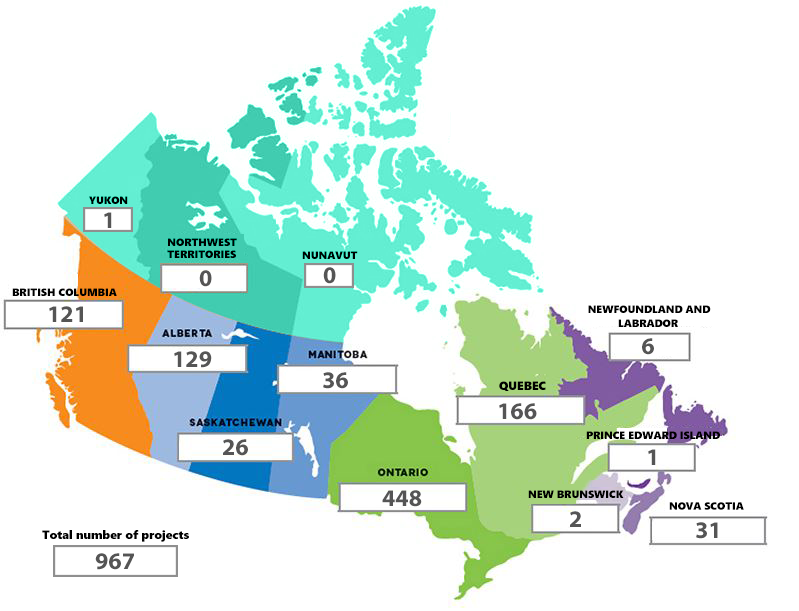
Long description
- Alberta - 129
- British Columbia - 121
- Manitoba - 36
- New Brunswick - 2
- Newfoundland and Labrador - 6
- Northwest Territories - 0
- Nova Scotia - 31
- Nunavut - 0
- Ontario - 448
- Prince Edward Island - 1
- Quebec - 166
- Saskatchewan - 26
- Yukon - 1
Research to tackle COVID-19: Mobilizing the research community to support Canada's pandemic response
Canada's research community has been a driving force behind the country's COVID-19 pandemic response – and CIHR is immensely proud to support this work.
Learn more about how Canadian research offered hope in the fight against COVID-19.
Investments in health research are investments in a stronger, healthier, and more prosperous Canada

Letting experts lead the way
The majority of our budget is devoted to open-ended funding competitions. This means that researchers can submit an application on any health-related topic of their choice.
This type of unfettered, investigator-led research has resulted in some of Canada's— and the world's—greatest scientific advancements, including:
- The mRNA technology that was used to develop the COVID-19 vaccine
- Evidence that sex and gender influence the ways men and women experience pain, respond to medications, and present symptoms of different health conditions
- Discoveries about how cells communicate—and the role this 'cell signalling' plays in cancer
- Better understanding of the social determinants of health (and, conversely, what puts people at greater risk for disease)

Research in priority areas
CIHR also supports national and international research projects that focus on specific health challenges, often because they have been identified as priorities by the Government of Canada or by one of CIHR's Institutes.
This has included research to:
- Respond to the COVID-19 pandemic
- Address the opioid crisis
- Improve care for pediatric cancers
- Develop better treatments for dementia
- Build healthier cities
- Find solutions to rising mental health challenges

Supporting the next generation
While research grants provide the "operating money" that enables great research to take place, salary awards for graduate students and doctoral fellows help ensure that the next generation of researchers will get the experience and support they need.
Among other programs, CIHR awards Canada Graduate Scholarships for health research trainees, investing over $1.98B since 2009.
We also create innovative skills training programs, design resources to support diverse career prospects, and collaborate with stakeholders to enhance training best practices.
- Date modified:

